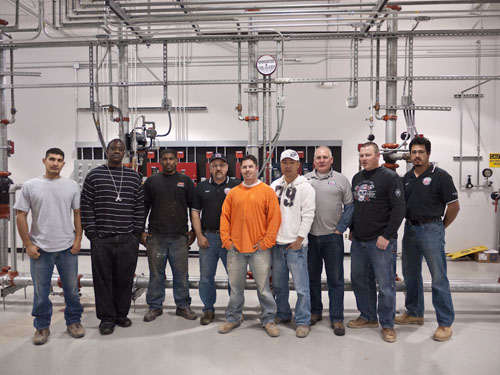
Sprinkler Fitters Local 483 Training Center
Organized Labor
Sprinkler fitters install systems that protect lives and property by putting out fires, activating alarms, and notifying the fire department. The systems they install must work in a variety of environments and circumstances. The systems not only have to protect finished buildings, but they have to protect the buildings during construction, when they are most vulnerable to fire. Sprinkler fitters install both wet and dry systems. Some use water, some gas, and some work in freezing conditions. Protecting computer systems, where water can do as much damage as fire, requires a very measured and controlled response. At the other extreme, fire in an aircraft hanger requires immediately flooding to prevent jet fuel from exploding. Sprinkler systems must not only withstand earthquakes, but must function during them. Meeting these challenges requires a multitude of different types of control systems, valves, and especially sprinkler heads. "Our responsibility starts underground at the curb and extends all the way to the last sprinkler at the last point in the building and everything in between. We cover every square foot of the building," Sprinkler Fitters Local 483 Apprenticeship Committee Training Director Jim Bollier explains. "There's a lot more to it than attaching a sprinkler head to the ceiling. We install hardware and interface with the electricians who do the electrical connections." The wiring can involve anything from smoke detectors to fire pumps requiring a 600 amp service. And once installed, the systems require periodic inspections and maintenance, including replacing sprinkler heads after a fire. With all that to do, sprinkler fitters are known for keeping up a fast pace, according to Bollier. "It's difficult initially, but then they get the principles of how the different types of systems work and a sense of the work ethic." Part of the necessity for the fast pace is the need to get the sprinkler pipe installed on the ceiling before the duct work gets in. Otherwise the sprinkler fitters have to work around the duct and other objects. New materials have made the job easier but have also increased the demand for more output. The sprinkler fitters apprenticeship program, an extension of the College of San Mateo, is a 10-semester, 5-year program. Apprentices work 40 hours a week during the day and then attend four hours of classes at night. The training center also offers continuing education classes to journeymen. With the frequent changes in the trade, journeymen usually attend at least one class a year to keep current. The center also offers OSHA 30 certification classes.
